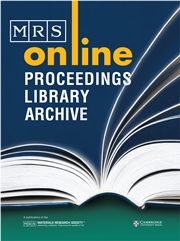Article contents
Biocorrosion of AISI 4340 Steel
Published online by Cambridge University Press: 22 February 2012
Abstract
The objective of the present work is to evaluate the Penicillium candidum filamentous fungi biocorrosion effects on AISI 4340 steel. Small AISI 4340 steel blocks are exposed to a biocorrosion process inside glass tubes containing culture media (Sabouraud Dextrose HIMEDIA broth) inoculated with Penicillium candidum spores for 14 days, at 25ºC constant temperature. The surface microstructures are evaluated by scanning electron microscopy, atomic force microscopy, and the chemical composition by energy dispersive X-ray spectroscopy. Comparison of micrographies before and after biocorrosion shows that surface structures present morphological alterations, suggesting corrosion wear. Grain contours can no longer be visualized and oxygen content on the steel surface increases to 32% after biocorrosion. Besides, topographic parameters like root mean square roughness (Rms), arithmetic mean roughness (Ra) and mean roughness (Rz) increase 57%, 132%, and 71%, respectively, from their initial values. It is concluded that AISI 4340 steel is reasonably susceptible to corrosion.
Information
- Type
- Articles
- Information
- MRS Online Proceedings Library (OPL) , Volume 1373: Symposium S4 – Advanced Structural Materials—2011 , 2012 , imrc-1373-s4-11
- Copyright
- Copyright © Materials Research Society 2012
References
REFERENCES
- 1
- Cited by

